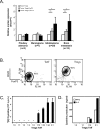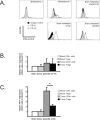Regulatory T cells and the PD-L1/PD-1 pathway mediate immune suppression in malignant human brain tumors
- PMID: 19028999
- PMCID: PMC2743219
- DOI: 10.1215/15228517-2008-104
Regulatory T cells and the PD-L1/PD-1 pathway mediate immune suppression in malignant human brain tumors
Abstract
The brain is a specialized immune site representing a unique tumor microenvironment. The availability of fresh brain tumor material for ex vivo analysis is often limited because large parts of many brain tumors are resected using ultrasonic aspiration. We analyzed ultrasonic tumor aspirates as a biosource to study immune suppressive mechanisms in 83 human brain tumors. Lymphocyte infiltrates in brain tumor tissues and ultrasonic aspirates were comparable with respect to lymphocyte content and viability. Applying ultrasonic aspirates, we detected massive infiltration of CD4+FoxP3+CD25(high) CD127(low) regulatory T cells (Tregs) in glioblastomas (n = 29) and metastatic brain tumors (n = 20). No Treg accumulation was observed in benign tumors such as meningiomas (n = 10) and pituitary adenomas (n = 5). A significant Treg increase in blood was seen only in patients with metastatic brain tumors. Tregs in high-grade tumors exhibited an activated phenotype as indicated by decreased proliferation and elevated CTLA-4 and FoxP3 expression relative to blood Tregs. Functional analysis showed that the tumor-derived Tregs efficiently suppressed cytokine secretion and proliferation of autologous intratumoral lymphocytes. Most tumor-infiltrating Tregs were localized in close proximity to effector T cells, as visualized by immunohistochemistry. Furthermore, 61% of the malignant brain tumors expressed programmed death ligand-1 (PD-L1), while the inhibitory PD-1 receptor was expressed on CD4+ effector cells present in 26% of tumors. In conclusion, using ultrasonic tumor aspirates as a biosource we identified Tregs and the PD-L1/PD-1 pathway as immune suppressive mechanisms in malignant but not benign human brain tumors.
Figures






References
-
- Legler JM, Ries LA, Smith MA, et al. Cancer surveillance series [corrected]: brain and other central nervous system cancers: recent trends in incidence and mortality. J Natl Cancer Inst. 1999;91:1382–1390. - PubMed
-
- Sawaya R, Ligon BL, Bindal RK. Management of metastatic brain tumors. Ann Surg Oncol. 1994;1:169–178. - PubMed
-
- Ransohoff RM, Kivisakk P, Kidd G. Three or more routes for leukocyte migration into the central nervous system. Nat Rev Immunol. 2003;3:569–581. - PubMed
Publication types
MeSH terms
Substances
LinkOut - more resources
Full Text Sources
Other Literature Sources
Medical
Research Materials

